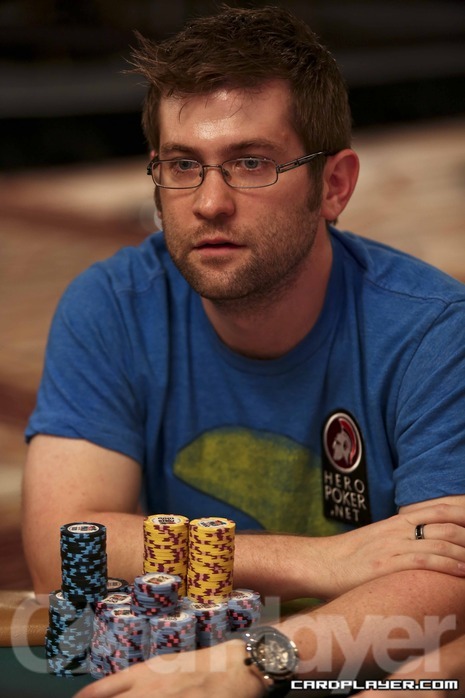






A Conversation With Poker Professional Gavin GriffinGriffin Talks About Recent Runner-Up Finish In WSOP Event |
|
|
 Last week, Card Player columnist Gavin Griffin made a deep run in the 2012 World Series of Poker event no. 8, $1,500 Omaha eight-or-better.
Last week, Card Player columnist Gavin Griffin made a deep run in the 2012 World Series of Poker event no. 8, $1,500 Omaha eight-or-better.
Griffin tore through a record field of 967 entrants before coming up just short, busting in second place for a $163,625 payday.
The 30-year-old poker pro became the youngest bracelet winner in poker history at the age of 23 in 2004, before his record was overtaken by a number of other players. In 2007, he took down the EPT Grand Final and in 2008, he became the first player to win poker’s Triple Crown by taking down the WPT Borgata Winter Open. Only three other players, Roland De Wolfe, Jake Cody and Bertrand Grospellier, have joined him since.
To date, the Darien, Illinois native has more than $4.9 million in tournament earnings.
We caught up with Griffin to discuss his recent run.
Julio Rodriguez: Can you talk about your recent run in the $1,500 Omaha eight-or-better event?
Gavin Griffin: It was a huge field and obviously a great tournament for me. Honestly, I don’t think there was a single break where I didn’t have more chips than when I started. At the final table, I’m not sure I would say that I was the best Omaha [eight-or-better] player there, but I’m pretty confident that I was playing the best that day.
JR: You’ve been playing a lot of low-stakes limit cash games, including some Omaha eight-or-better. How different is the game when played in a tournament format?
GG: It was readily apparent at the final table just how different Omaha hi/lo tournaments are from the cash games. There were several situations where someone played a hand that would’ve totally been reasonable in a cash game, but was actually quite ridiculous in a tournament setting. Even at the final table, where big pay jumps are on the line, there were players getting six or seven bets in with a pair and a bad low, not thinking about the extreme short stack still sitting at the table. There’s more to tournaments than just your hand. There’s also ICM considerations, your stack size and your position at the table.
JR: You got a hold of a lot of chips and it seemed that many of the players were afraid to play back at you.
GG: Yeah, there were some really interesting situations during the final table that allowed me to really mop up some chips and it mostly had to do with how I attacked the short stacks. I was able to kind of exploit that a bit during the final table. I think my VPIP [Voluntarily Put Into Pot] was probably something like 65 percent and that’s because it was clear to me who was sitting back and waiting to move up the pay ladder and who was willing to play back at me. They kept folding, so I kept raising. For awhile, it was that simple.
Once we got three-handed, Herbert Tapscott started to get really sticky in pots and became kind of tough to play against. Earlier, it was much easier to get him off some hands, but once we got short-handed, he definitely adjusted. During heads-up play, I actually tried to slow down a bit and play smaller pots with him. I was almost exclusively limping and I don’t think I ever three-bet him, just because I thought I had the edge post flop. We battled back and forth for a long time before the blinds kind of deciding things. There was just 15 minutes left in the day and we were playing 100,000-200,000 with pretty shallow stacks and he went on a rush. That’s just the way it goes sometimes.
JR: It was a great run and you earned $163,625 for your efforts, but it must have been bittersweet to fall short of your second bracelet.
GG: There’s no question that he definitely deserved to win. I think we both did and it could have gone either way. Obviously, I’m disappointed that I didn’t pull it off, but it was still a good score and it guaranteed that I’d have a winning World Series of Poker.
JR: Your first column for Card Player magazine had a lot of people talking, but there seems to be some misconceptions about your financial situation. Would you care to set the record straight?
GG: My wife and I are doing fine. She’s got a great job and I’m doing well. I mean, I moved down in stakes for reasons other than just money. People ask me, ‘How are you playing $8-$16, $15-$30 and $20-$40 games and also playing in big buy-in tournaments?’ Well, it’s the same reason why 95 percent of the poker world is playing in big buy-in tournaments. I, like many others, have been backed for quite a while now, which obviously takes some of the pressure off and helps me to concentrate on my overall game.
The unfortunate part of this tournament is that I got zero dollars from it. Tournaments are rough, especially these days. They are way tougher than they used to be. Most of my cashes in the past year or so have been in the smaller buy-in events. Well, cashing is great, but if you only cash in the small events and brick all of the $10k events, then you are going to rack up some make up no matter how well you do. It’s just how it goes. Anyway, I’m pretty confident in my game moving forward and I know it’s just a matter of time before it all comes together.
For complete coverage of the summer poker festival, check out our WSOP landing page.
